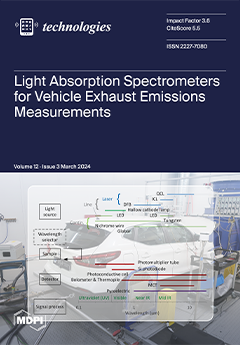Light-duty vehicle emission regulations worldwide set limits for the following gaseous pollutants: carbon monoxide (CO), nitric oxides (NO
X), hydrocarbons (HCs), and/or non-methane hydrocarbons (NMHCs). Carbon dioxide (CO
2) is indirectly limited by fleet CO
2 or fuel consumption targets. Measurements
[...] Read more.
Light-duty vehicle emission regulations worldwide set limits for the following gaseous pollutants: carbon monoxide (CO), nitric oxides (NO
X), hydrocarbons (HCs), and/or non-methane hydrocarbons (NMHCs). Carbon dioxide (CO
2) is indirectly limited by fleet CO
2 or fuel consumption targets. Measurements are carried out at the dilution tunnel with “standard” laboratory-grade instruments following well-defined principles of operation: non-dispersive infrared (NDIR) analyzers for CO and CO
2, flame ionization detectors (FIDs) for hydrocarbons, and chemiluminescence analyzers (CLAs) or non-dispersive ultraviolet detectors (NDUVs) for NO
X. In the United States in 2012 and in China in 2020, with Stage 6, nitrous oxide (N
2O) was also included. Brazil is phasing in NH
3 in its regulation. Alternative instruments that can measure some or all these pollutants include Fourier transform infrared (FTIR)- and laser absorption spectroscopy (LAS)-based instruments. In the second category, quantum cascade laser (QCL) spectroscopy in the mid-infrared area or laser diode spectroscopy (LDS) in the near-infrared area, such as tunable diode laser absorption spectroscopy (TDLAS), are included. According to current regulations and technical specifications, NH
3 is the only component that has to be measured at the tailpipe to avoid ammonia losses due to its hydrophilic properties and adsorption on the transfer lines. There are not many studies that have evaluated such instruments, in particular those for “non-regulated” worldwide pollutants. For this reason, we compared laboratory-grade “standard” analyzers with FTIR- and TDLAS-based instruments measuring NH
3. One diesel and two gasoline vehicles at different ambient temperatures and with different test cycles produced emissions in a wide range. In general, the agreement among the instruments was very good (in most cases, within ±10%), confirming their suitability for the measurement of pollutants.
Full article





